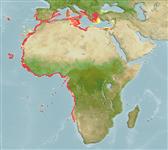Teleostei (teleosts) >
Eupercaria/misc (Various families in series Eupercaria) >
Sparidae (Porgies)
Etymology: Dentex: Latin, dens, dentis = teeth (Ref. 45335).
More on author: Bloch.
Environment: milieu / climate zone / depth range / distribution range
Ecology
Marine; benthopelagic; oceanodromous (Ref. 51243); depth range 30 - 500 m (Ref. 3198). Subtropical; 42°N - 22°S, 26°W - 36°E
Eastern Atlantic: off Portugal and Strait of Gibraltar to Namibia, including Cape Verde and the Canary Islands. Also from the Mediterranean.
Length at first maturity / Size / Weight / Age
Maturity: Lm 10.8, range 14 - ? cm
Max length : 65.0 cm TL male/unsexed; (Ref. 3397); common length : 30.0 cm TL male/unsexed; (Ref. 2683)
Inhabit rocky or sandy bottoms; individuals descending to greater depths with growth. The stocks migrate seasonally between the coast and deeper waters in accordance with local hydrographic conditions and their life cycle. Feed mainly on fish and crustaceans; the young on plankton (Ref. 3688). Gonochorists (Ref. 4781).
Bauchot, M.-L. and J.-C. Hureau, 1990. Sparidae. p. 790-812. In J.C. Quero, J.C. Hureau, C. Karrer, A. Post and L. Saldanha (eds.) Check-list of the fishes of the eastern tropical Atlantic (CLOFETA). JNICT, Lisbon; SEI, Paris; and UNESCO, Paris. Vol. 2. (Ref. 3688)
IUCN Red List Status (Ref. 130435)
Threat to humans
Harmless
Human uses
Fisheries: commercial; gamefish: yes
More information
ReferencesAquacultureAquaculture profileStrainsGeneticsElectrophoresesHeritabilityDiseasesProcessingNutrientsMass conversion
Tools
Special reports
Download XML
Internet sources
Estimates based on models
Preferred temperature (Ref.
123201): 13 - 16.8, mean 14.9 °C (based on 168 cells).
Phylogenetic diversity index (Ref.
82804): PD
50 = 0.5001 [Uniqueness, from 0.5 = low to 2.0 = high].
Bayesian length-weight: a=0.01148 (0.00900 - 0.01464), b=3.03 (3.00 - 3.06), in cm total length, based on LWR estimates for this species (Ref.
93245).
Trophic level (Ref.
69278): 3.5 ±0.44 se; based on food items.
Resilience (Ref.
120179): Medium, minimum population doubling time 1.4 - 4.4 years (K=0.16-0.25; tmax=13; tm=2).
Prior r = 0.98, 95% CL = 0.65 - 1.47, Based on 1 stock assessment.
Fishing Vulnerability (Ref.
59153): Moderate to high vulnerability (54 of 100).
Climate Vulnerability (Ref.
125649): Low vulnerability (13 of 100).
Nutrients (Ref.
124155): Calcium = 51 [29, 94] mg/100g; Iron = 1.01 [0.58, 1.75] mg/100g; Protein = 19.3 [17.7, 20.7] %; Omega3 = 0.452 [0.262, 0.807] g/100g; Selenium = 43.7 [22.3, 85.4] μg/100g; VitaminA = 17.4 [5.7, 51.2] μg/100g; Zinc = 0.637 [0.453, 0.886] mg/100g (wet weight); based on
nutrient studies.
